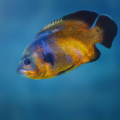In the world of Oscar fish species, one of the most striking varieties is the Red Oscar fish. This article is going to teach you how to Feed your Red Oscar fish with the best diet and care regimen.

Comprehensive Guide to Red Oscar Fish Care
If you need a popular aquarium fish to drive interaction when people approach your tank, then the Red Oscar is for you.
It’s native to the Amazon and Paraná river basins in South America but has since migrated to North America and other countries worldwide through selective breeding.
Keep reading for more on its appearance, characteristics, and how to care for this vibrant Oscar fish without fussing.
Appearance and Characteristics

The Red Oscar’s appearance is a bright red-to-orange-red hue with dark brown-to-black markings that create a striking contrast. Under the best conditions, they can grow up to about 12 inches (30 cm) in length and weigh up to 3 pounds (1.4 kg).
This variety also has common Oscar fish characteristics such as its intelligence, curiosity, territorial nature, and socialization.
Although they prefer to be in pairs or small groups, Red Oscar fish can become aggressive in tight spaces with no hiding spots.
Besides that minor “character flaw,” this vibrant aquarium fish will be a good addition to the right community tank.
Ideal Tank Setup for Red Oscars

The optimal Red Oscar tank setup would be a minimum size of 75 gallons, with temperatures between 72-82°F (22-28°C) and a pH of 6.5-8.0.
Other aquarium conditions for Oscars you must consider are water hardness and clarity. Maintain a hardness of 5-15dGH and ensure water is clear and well-oxygenated.
You can protect the water quality by securing the tank with an aerated lid and using a water filter.
Other tank requirements include heaters and thermometers for maintaining warmth similar to the Amazon River, as well as soft substrates and decor like fine gravel and sand to keep from harming your Red Oscar fish while they move in the aquarium.
Water Quality and Maintenance
Maintaining healthy Red Oscars requires continuous tank maintenance.
To maintain the necessary water quality for Red Oscars, change the aquarium water regularly, at least every one to two weeks.
Avoid overfeeding your pets so they don’t waste food and contaminate the water. Don’t overcrowd the aquarium because it leads to stress and aggression.
Ensure that your aquarium water parameters stay within the recommended range, and use good filtration systems to improve the nitrogen cycle and convert ammonia waste before it becomes poisonous. Remember these key water parameters:
- Ammonia (NH3): 0 ppm
- Nitrite (NO2): 0 ppm
- Nitrate (NO3): < 20 ppm
- pH: 6.5-8.0
- Temperature: 72-82°F (22-28°C)
- Hardness: 5-15 dGH
By prioritizing water quality and performing regular tank maintenance, you can create a healthy and thriving environment for your Red Oscars. Remember, a well-maintained tank is essential for the long-term health and happiness of your aquatic friends!
Diet and Nutrition

An adequate Red Oscar diet that meets their nutritional needs and ensures they grow well would be balanced.
The Ultimate Guide to Fish Food: Pros and Cons & Best Choices covers dietary needs, recommended foods, and feeding schedules to meet these fish nutrition basics.
Dietary needs include basic food classes like protein, vegetables, fiber, and fruits. You should provide a diet rich in omega-3 fatty acids, vitamins, and minerals.
Feeding Red Oscars should be 2-3 times a day, in quantities they can consume within 1-2 minutes.

High-quality commercial flakes or pellets should make up 40-50% of the diet. Live or frozen foods like brine shrimp, bloodworms, and earthworms should make up 20-30%, and vegetables like zucchini, spinach, and peas make up the remaining 10-20%. Fruits like berries and melons can be occasional treats.
And that’s how you build a balanced fish diet.
Common Health Issues and Solutions
Red Oscars are generally hardy fish, but like all living creatures, they are prone to certain health issues. Here are some Red Oscar health issues and how you can prevent them.
Fin Rot
This bacterial infection causes frayed or rotting fins in fish. To prevent this, maintain optimal water quality through frequent water changes.
Treatment: Administer antibiotics or antifungal medications and trim damaged fins to prevent further decay.
Swim Bladder Disease
This is an inflammation of Oscar’s swim bladder, which causes buoyancy issues. Prevent this by feeding your fish a balanced diet and keeping the aquarium water clean!
Treatment: Treat with antibiotics or anti-inflammatory medications, perform a partial water change, and add a water conditioner.
Hole-in-the-Head(HITH)
This bacterial infection causes holes in the fish’s head and face. Ensuring good water quality and feeding a balanced diet will prevent it.
Treatment: Treat with antibiotics or antifungal medications.
Prevention Tips
You should note these care tips to keep your fish healthy and bubbly.
- Perform partial water changes (25-50%) every 1-2 weeks and regularly check water parameters.
- Ensure sufficient space (at least 1 gallon per inch of fish) and Isolate new fish for 2-4 weeks before introducing them to the main tank.
By being aware of these common health issues, you will be better equipped to treat Oscar fish diseases and ensure your fish remain healthy and buoyant.
Breeding Red Oscars
Breeding Red Oscars requires careful planning, so here’s a step-by-step guide on how to identify breeding pairs, facilitate breeding, and care for the fry:
Identifying Breeding Pairs
Mature Red Oscars (2-3 years old) with vibrant coloration, robust fins, and no visible defects. Male Oscars have a more pointed dorsal fin, while females have a rounded dorsal fin.
This video has been very helpful in identifying the sex of Oscar fish, I highly recommend it:
After selecting your breeding pairs, introduce them to a large tank (min. 100 gallons) and observe their behavior, separating the pairs that show interest in each other.
Breeding Process
Oscar fish reproduction takes place on a flat, smooth surface such as a rock or a breeding cone, so you must provide this. Optimal water parameters should be maintained.
The male courts the female, who deposits her eggs (up to 2,000) on the prepared surface for fertilization.
After fertilization, remove the adults to prevent cannibalism and keep the eggs in a separate container with gentle water circulation and aeration.
Caring for Oscar Fry
The final leg of the breeding process is caring for Oscar fry. Eggs will hatch within 24-48 hours, releasing larvae (fry).
Feed the fry infusoria or newly hatched brine shrimp and provide a separate container with a sponge filter and heater.
After a week or two, the fry will develop their fins and start swimming. Gradually introduce larger foods at this point.
Once the fry reaches 1-2 inches in length, transfer them to a larger tank (at least 20 gallons) with proper filtration and hiding places.
Again, regularly check water parameters, perform water changes, and ensure adequate food and shelter for the growing fry.
Tank Mates for Red Oscars
Choosing Red Oscar tank mates must be done carefully as these fish are territorial and semi-aggressive. Here are some specific compatible fish with Oscars, considering their temperament and compatibility:

Silver Dollars

Plecos

Convict Cichlids

Gouramis

Synodontis Catfish
In selecting compatible fish with Oscars, avoid small or timid fish, as Oscars may bully or eat them. You should keep only one Oscar per tank, as they’re territorial and introduce tank mates gradually while monitoring behavior and adjusting the community as needed.
By selecting compatible tank mates and following these guidelines, you can create a thriving community tank with Red Oscars as the centerpiece.
Behavioral Traits
Red Oscars are intelligent aquarium fish known for their unique and fascinating behaviors. Which include:
They are generally solitary but can form pairs or small groups in the wild. In captivity, they can be kept alone or with compatible tank mates.
During breeding, they are observed to display courtship behavior, like fin-nipping and chasing.
Territorial Nature
One notable Oscar fish trait is their strong disposition to their territory. They will strongly defend their territory, including their food and shelter, and often mark their territory with feces and urine.
Intelligence
Oscar fish recognize and respond to their owner’s presence and voice. They are also capable of problem-solving and learning tricks and have been observed using tools, like rocks, to open shells.
Other notable Oscar fish traits include:
- They are active swimmers, constantly exploring their environment.
- They love to dig and rearrange substrates and decorations.
- Display a unique “wrestling” behavior, where they lock their mouths and twist their bodies.
Understanding Red Oscar’s behavior is important to providing a suitable environment and appropriate tank mates.
By recognizing their intelligence, territorial nature, and social interactions, you create an exciting aquarium experience for you and your Oscar.
Selecting and Purchasing Red Oscars

If you intend on buying Red Oscars, remember these general highlights I’ll give on what to look out for when selecting Oscar fish:
- Swimming Behavior: Healthy Red Oscars should swim actively and freely in their tank.
- Coloration: Red Oscars should display a vibrant red-orange color with no fading or discoloration.
- Body Type: Healthy Red Oscars have plump, firm bodies with no visible signs of malnutrition or disease.
- Inspect for Damage or Labored Breathing: Avoid fish with damaged fins, labored breathing, or visible signs of stress.
Reputable sources you could purchase Red Oscars from:
- Local aquarium stores
- Breeder websites
- Aquarium clubs
- Pet supply chains
Remember to research and understand the needs and care requirements of Red Oscars before purchasing. Ensure you can provide the appropriate environment needed to maintain a healthy aquarium fish.
Conclusion
The Red Oscar is a unique and captivating species that requires specific care to thrive. Its striking appearance, intelligent nature, and active personality make it a fascinating addition to your tank. So, why not give it the best care for a long and healthy life?
By following my tips on aquarium fish care, you can enjoy the rewards of owning this beautiful fish. Remember that successful Oscar fishkeeping requires dedication and time.
You only need to provide a balanced diet, change water regularly, and keep suitable tank mates.
Happy fish keeping!











1 thought on “Everything You Need to Know About Red Oscar Fish Care ”